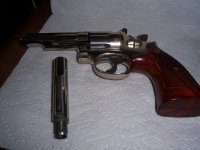Johnny Diamond
Member
Hey all I'm new here and it seemed like this was the place to come. 2 Christmas's ago, wife brought home a new blued 4 1/4" combat magnum, beautiful piece, I've always been a Ruger man (single action) so I had to research. Apparently there were issues in the past with 357 mag rounds....ie only use 38 special etc. I have found out barrels are now stainless steel and have other improvements. I have an old model Vaquero and a Marlin 1894, also a Rossi 92 all in 357 mag and reloaded for those hornady 158 xtp's starline brass cci small pistol primers 1258 fps from an 8" barrel should I be concerned [emoji45] ?
Sent from my SM-G973U using Tapatalk
Sent from my SM-G973U using Tapatalk


